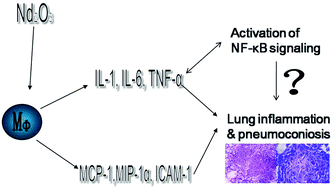Activation of NF-κB signaling in rare earth neodymium oxide particle-induced acute lung injury
Abstract
Neodymium is widely applied in industrial materials worldwide, and most of the supply is produced in China. However, neodymium oxide dust exposure can cause pronounced lung injury and pneumoconiosis. This study investigated the process of Nd2O3-induced acute lung injury and explored the activation of NF-κB by employing an Nd2O3-instilled rat model. H&E staining, total cell number and total protein amount in broncho-alveolar lavage (BAL) fluid revealed that Nd2O3 instillation caused pronounced acute lung injury, which is characterized by the infiltration of inflammatory cells, alveolar septal thickening, fibroblast proliferation and collagen deposition in the lungs of the rats. Meanwhile, immunoblot analysis and EMSA assay indicated that Nd2O3 instillation induced the NF-κB signaling pathway. These results suggest that Nd2O3-induced lung acute injury may be regulated by the NF-κB signaling pathway. This report could be the first in vivo mechanistic study of pneumoconiosis induced by Nd2O3, providing insights for the development of clinical therapeutic strategies to prevent Nd2O3-induced pneumoconiosis.


 Please wait while we load your content...
Please wait while we load your content...